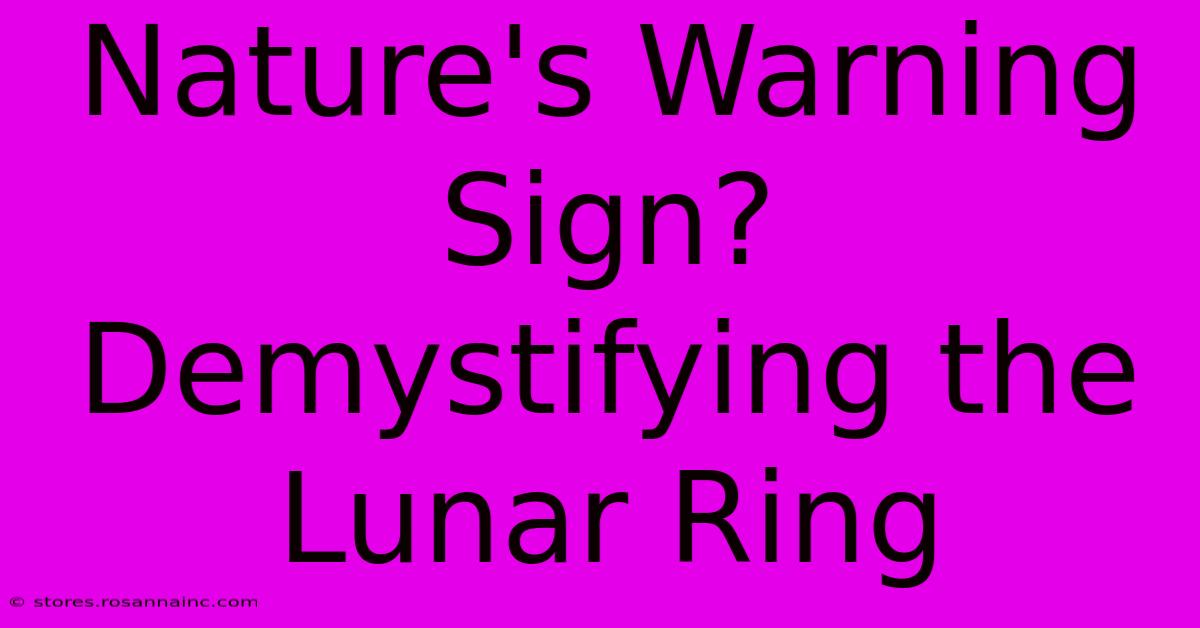Nature's Warning Sign? Demystifying The Lunar Ring

Table of Contents
Nature's Warning Sign? Demystifying the Lunar Ring
Have you ever gazed up at the night sky and witnessed a halo encircling the moon? This ethereal ring, often tinged with pastel colours, is known as a lunar halo, a captivating atmospheric phenomenon that has sparked curiosity and even superstition throughout history. But what exactly is a lunar halo, and does it truly hold any significance as a "nature's warning sign"? Let's delve into the science behind this beautiful display.
Understanding the Science Behind Lunar Halos
A lunar halo, also called a 22° halo, isn't a lunar event itself. It's an optical illusion, a result of the interaction of moonlight with ice crystals high in the Earth's atmosphere, typically within cirrus clouds at altitudes of 5-10 kilometers. These ice crystals act as tiny prisms, refracting the moonlight at a 22-degree angle. This refraction, specifically, is what creates the luminous ring around the moon.
The Role of Ice Crystals
The shape and orientation of the ice crystals are crucial. Hexagonal, plate-like crystals are most effective at creating the halo effect. As moonlight passes through these crystals, it's bent, separating into its constituent colours, although this is less pronounced than in a rainbow. This is why lunar halos often appear whitish, with subtle hints of color, usually red on the inside and blue on the outside.
Beyond the Beauty: Weather Implications
While lunar halos are visually stunning, they have historically been associated with impending weather changes. This association stems from the fact that cirrus clouds, the culprits behind halos, are often precursors to larger weather systems. The presence of cirrus clouds suggests a change in upper atmospheric conditions, potentially indicating:
- Approaching Storm Systems: Cirrus clouds frequently precede the arrival of warm fronts and associated stormy weather. The moisture and atmospheric instability that creates cirrus clouds can often lead to more significant weather events within 12-24 hours.
- Changes in Atmospheric Pressure: The formation of cirrus clouds can signal shifts in atmospheric pressure, which often influence weather patterns.
Important Note: Correlation, Not Causation
It's crucial to understand that a lunar halo does not cause bad weather. It's simply an indicator that atmospheric conditions are changing. The presence of a halo is a correlation, not a direct cause, of upcoming weather changes. While it might be a useful sign for experienced weather observers, it's not a definitive prediction.
Dispelling Myths and Superstitions
Throughout history, lunar halos have been imbued with various interpretations, often tied to folklore and superstitions. Some cultures viewed them as omens of bad luck or impending disasters. However, understanding the scientific basis behind this atmospheric phenomenon helps to separate fact from fiction. The beauty of a lunar halo lies in its scientific explanation, not in mystical interpretations.
Observing and Photographing Lunar Halos
Witnessing a lunar halo is a truly special experience. To increase your chances of seeing one:
- Look for high-altitude cirrus clouds. These thin, wispy clouds are ideal for halo formation.
- Observe the moon on clear nights. Light pollution can diminish the visibility of the halo.
- Use a camera to capture the detail. A long-exposure photograph can reveal the subtle colours and details of the halo more clearly.
Conclusion: A Natural Wonder
The lunar halo remains a mesmerizing natural phenomenon. While it's often associated with impending weather changes, it's crucial to remember that it's an indicator, not a predictor. Appreciate its beauty for what it is: a spectacular display of light and ice crystals high above us, a testament to the fascinating dynamics of our atmosphere. The next time you see a ring around the moon, remember the science behind this celestial spectacle and enjoy its ethereal glow.

Thank you for visiting our website wich cover about Nature's Warning Sign? Demystifying The Lunar Ring. We hope the information provided has been useful to you. Feel free to contact us if you have any questions or need further assistance. See you next time and dont miss to bookmark.
Featured Posts
-
Relocating To 562 Discover Your Future Neighborhood
Feb 09, 2025
-
1 1 Draw Real Madrid Vs Atletico
Feb 09, 2025
-
Whats A Grown Up Bull Called The Answer Might Surprise You
Feb 09, 2025
-
Conoces El Secreto Del Exito De Los Hijos De Pepe Aguilar
Feb 09, 2025
-
Jonathan Brandis Movies And Tv Shows A Complete Guide
Feb 09, 2025
